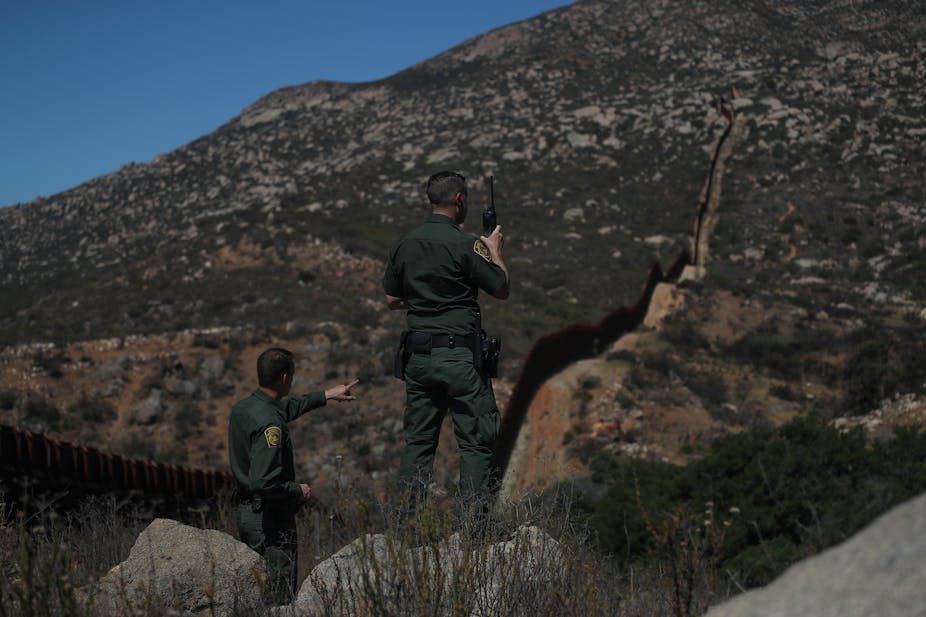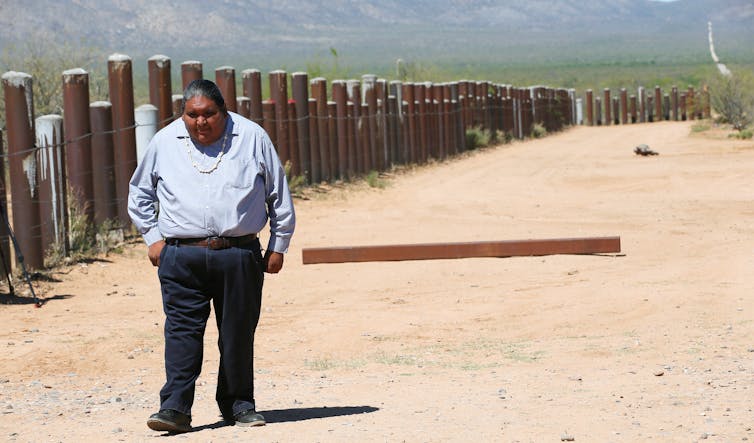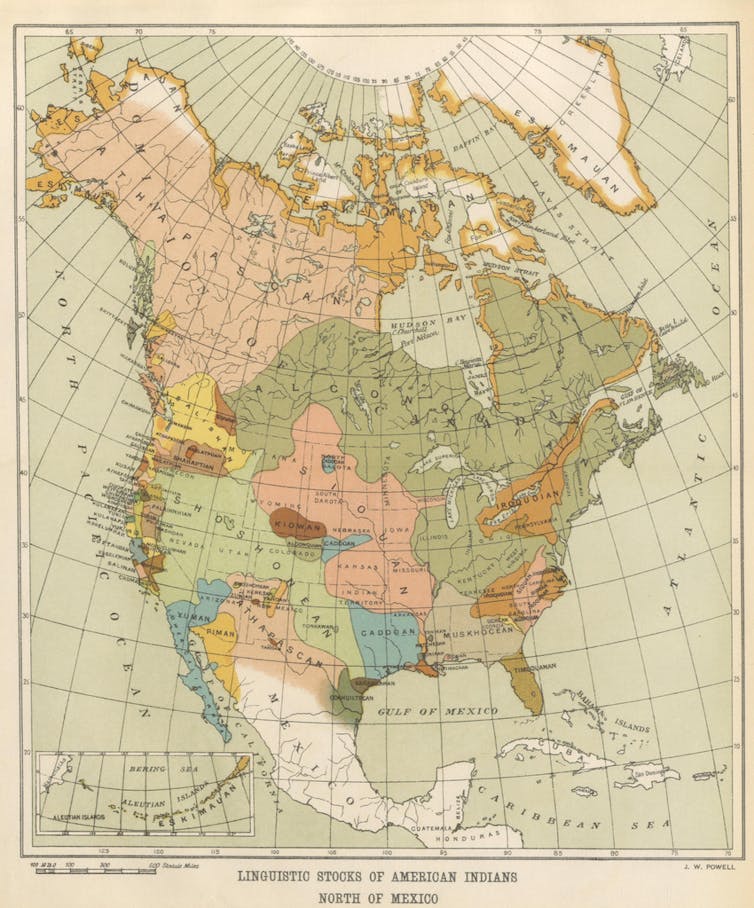Het
hieronder opgenomen artikel werd geschreven door Christina Leza,
‘taal antropoloog’ en eerder gepubliceerd op The Conversation. Leza
betoogt volkomen terecht dat de oorspronkelijke bevolking van de VS
en Mexico, ‘indianen’, het slachtoffer zijn van getrokken grenzen en dat in grotere mate als Trump zijn zin krijgt en de hele grens met Mexico
afgeschermd zal worden middels een ‘border wall….’

De grens
tussen de VS en Mexico is voor deze oorspronkelijke volkeren een denkbeeldige,
een grens getrokken door de witte kolonisten en hun nazaten, die deze volkeren met een genocide voor
een groot deel hebben uitgemoord……. De stamverbanden in het zuiden
van de VS en het noorden van Mexico gaan ver over beide grenzen…..
Voor hun
ceremonies zijn de mensen van deze volkeren aangewezen op stammen die over de grens leven en een groot aantal van deze mensen zijn zelfs voor de eerste levensbehoeften aangewezen op winkels over de grens…. Zo is een
bepaald deel van een stam in Mexico voor de boodschappen afhankelijk
van de dichtstbijzijnde plaats, in de VS…… Een veeboer van de O’odham nation moet voor het water dat hij nodig heeft, normaal gesproken op gezichtsafstand, nu mijlen ver omrijden om daar bij te kunnen……. (hetzelfde maken Palestijnen mee op de illegaal door Israël bezette West Bank, hoewel bijvoorbeeld veel boeren daar hun land in het geheel niet meer kunnen bereiken……)
Bij de
grensovergangen worden deze mensen niet zelden getreiterd door
grenswachten en het is altijd weer afwachten of ze wel doorgelaten
zullen worden, zo twijfelt dit leeghoofdige psychopathische geteisem
aan het feit of ze wel echt tot een stam van ‘indianen’ behoren en
moeten ze dit aantonen door in hun eigen taal te spreken, of zelfs te
zingen, bij weigering kunnen ze worden geweigerd…….
Zoals
gezegd de witte kolonisten hebben deze oorspronkelijke volkeren bijna
uitgemoord (in heel Amerika, de grootste genocide ooit….) en nog
dagelijks worden deze mensen op alle mogelijke manieren dwars
gezeten, neem ook de aanleg van oliepijpleidingen, die op zeker gaan lekken door rivieren en over voor deze mensen heilige
gronden…… (een paar van die enorme en lange leidingen lekken al en dat binnen een jaar na in gebruik te zijn genomen…..)
Kortom de VS, de grootste terreurentiteit op onze kleine aarde, oefent niet
alleen grootschalige terreur uit in verre landen, maar ook in eigen
land, want een dergelijke behandeling, als bij de Israëlische
blokkades op door hen illegaal bezette West Bank, kan je niet anders
dan als terreur zien…….
Het hieronder opgenomen artikel nam ik over van Anti-Media, de foto’s komen van The Conversation:
For
Native Americans, US-Mexico Border is an Imaginary Line

March
19, 2019 at 8:09 pm
Written
by Christina Leza, The
Conversation
![]()
Christina Leza, Associate Professor of Anthropology, Colorado College
(CONVERSATION) — Immigration
restrictions were making life difficult for Native Americans who live
along – and across – the U.S.-Mexico border even before President
Donald Trump declared
a national emergency to
build his border wall.
The
traditional homelands of 36 federally
recognized tribes –
including the Kumeyaay, Pai, Cocopah, O’odham, Yaqui, Apache and
Kickapoo peoples – were split in two by the 1848
Treaty of Guadalupe Hidalgo and
1853 Gadsden
Purchase,
which carved modern-day California, Arizona, New Mexico and Texas out
of northern Mexico.
Today,
tens of thousands of people belonging to U.S. Native tribes live in
the Mexican states of Baja
California, Sonora, Coahuila and Chihuahua,
my research estimates. The Mexican government does not recognize
indigenous peoples in Mexico as nations as the U.S. does, so there is
no enrollment system there.
Still,
many Native people in Mexico routinely cross the U.S.-Mexico border
to participate in cultural events, visit religious sites, attend
burials, go to school or visit family. Like other “non-resident
aliens,” they must pass through rigorous
security checkpoints,
where they are subject to interrogation, inspection and rejection
or delay.
Many
Native Americans I’ve interviewed for anthropological
research on indigenous activism call
the U.S.-Mexico border “the imaginary line” – an invisible
boundary created by colonial powers that claim
sovereign indigenous territories as
their own.
A border
wall would further separate Native peoples from
friends, relatives and tribal resources that span the U.S.-Mexico
border.
Homelands
divided
Tribal
members say that many Native Americans in the U.S. feel detached from
their relatives in Mexico.
“The
effect of a wall is already in us,” Mike Wilson, a member of the
Tohono O’odham Nation, who lives in Tucson, Arizona, told me. “It
already divides us.”
The
Tohono O’odham are among the U.S. federal tribes fighting
the government’s efforts to
beef up existing security with a border wall. In late January, the
Tohono O’odham, Pascua Yaqui and National Congress of Indian
Americans met to
create a proposal for facilitating indigenous border crossing.
The
Tohono O’odham already know how life changes when traditional lands
are physically partitioned.

Verlon Jose, vice-chairman of the Tohono O’odham Nation, at the border barrier that traverses the Tohono O’odham reservation in Chukut Kuk, Ariz., in 2017. Reuters/Rick Wilking
By
U.S. law, enrolled Tohono O’odham members in Mexico are eligible to
receive educational and medical services in Tohono
O’odham lands in the U.S.
That
has become difficult since 2006, when a steel
vehicle barrier was
built along most of the 62-mile stretch of U.S.-Mexico border that
bisects the Tohono O’odham Nation.
Previously,
to get to the U.S. side of Tohono O’odham territory, many tribe
members would simply drive across their land. Now, they must travel
long distances to official ports of entry.
One
Tohono O’odham rancher told The New York Times in 2017 that he must
travel several miles to draw
water from a well 100 yards away from his home –
but in Mexico.
And
Pacific Standard magazine reported in
February 2019 that three Tohono O’odham villages in Sonora, Mexico,
had been cut off from their nearest food supply, which was in the
U.S.
Native
rights
Land
is central to Native communities’ historic,
spiritual and cultural identity.
Several
international agreements – including the United
Nations Declaration on the Rights of Indigenous Peoples –
confirm these communities’ innate rights to draw
on cultural and natural resources across
international borders.

An
1894 map of indigenous North American languages shows how Native
homelands span modern-day national borders. British
Library (jammer overigens dat men niet eenzelfde kaart opnam voor Mexico)
The
United States offers few such protections.
Officially,
various federal laws and treaties affirm the rights of federally
recognized tribes to cross between the U.S., Mexico and Canada.
The Jay
Treaty of 1794 grants
indigenous peoples on the U.S.-Canada border the right to freely pass
and repass the border. It also gives Canadian-born indigenous persons
the right to live and work in the United States.
The American
Indian Religious Freedom Act of
1978 says that the U.S. will protect and preserve Native American
religious rights, including “access to sacred sites” and
“possession of sacred objects.” And the 1990 Native
American Graves Protection and Repatriation Act protects
Native American human remains, burial sites and sacred objects.
United
States law also requires that federally recognized sovereign tribal
nations on the U.S.-Mexico border must be consulted
in federal border enforcement planning.
In
practice, however, the free passage of Native people who live across
both the United States’ northern or southern border is curtailed
by strict
identification laws.
The
United States requires anyone entering the country to present a
passport or other U.S.-approved identification confirming their
citizenship or authorization to enter. The Real ID Act of 2005 allows
the Department of Homeland Security (DHS) secretary to waive any U.S. law –
including those protecting indigenous rights – that may
impede border
enforcement.
Several
standard U.S. tribal identification documents – including Form
I-872 American Indian Card and
enhanced tribal photo identification cards – are approved
travel documents that
enable Native Americans to enter the U.S. at land ports of entry.
Arbitrary
identity tests
Only
the American
Indian Card,
which is issued exclusively to members of the Kickapoo tribes,
recognizes indigenous people’s right to cross the border regardless
of citizenship.
According
to the Texas
Band of Kickapoo Act of 1983,
“all members of the Band” – including those who live in Mexico
– are “entitled to freely pass and repass the borders of the
United States and to live and work in the United States.”
The
majority of indigenous Mexicans wishing to live or work in the United
States, however, must apply
for immigrant residence and work authorization like
any other person born outside of the U.S. The relevant tribal
governments in the U.S. may also work with Customs and Border Patrol
to waive certain travel document requirements on a case-by-case basis
for short-term visits of Native members from Mexico.
Since
border patrol agents have expansive discretionary
power to
refuse or delay entries in the interest of national security, its
officers sometimes make arbitrary requests to verify Native identity
in these cases.
Such
tests, my research shows, have included asking people to speak their
indigenous language or – if the person is crossing to participate
in a Native ceremony – to perform a traditional song or dance.
Those who refuse these requests may
be denied entry.
Border
agents at both the Mexico and Canada
borders have
also reportedly mishandled or destroyed Native ceremonial or
medicinal items they deem suspicious.
“Our
relatives are all considered ‘aliens,’” said the Yaqui elder
and activist José Matus. “[T]hey’re not aliens. … They’re
indigenous to this land.”
“We’ve
been here since time immemorial,” he added.
